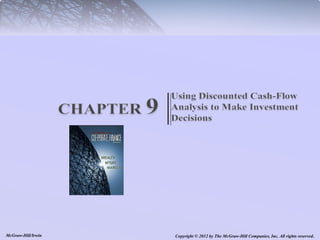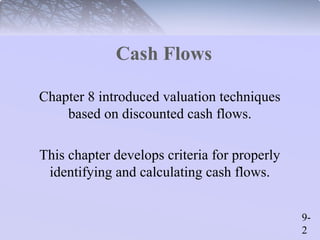Chap009
- 1. McGraw-Hill/Irwin Copyright ÂĐ 2012 by The McGraw-Hill Companies, Inc. All rights reserved.
- 2. 9- 2 Cash Flows Chapter 8 introduced valuation techniques based on discounted cash flows. This chapter develops criteria for properly identifying and calculating cash flows.
- 3. 9- 3 Identifying Cash Flows: Cash Flow vs. Accounting Income Discount actual cash flows, not necessarily net income. Using accounting income, rather than cash flow, could lead to erroneous decisions.
- 4. 9- 4 NPV: Accounting Income - Example A project costs $2,000 and is expected to last 2 years, producing cash income of $1,500 and $500 respectively. The cost of the project can be depreciated at $1,000 per year. Given a 10% required return, compare the NPV using cash flows to the NPV using accounting income. Year 1 Year 2 Cash Inflow $1,500 $ 500 Depreciation -$1,000 -$1,000 Accounting Income +$ 500 - $ 500 + + - = Apparent NPV = 0 500 500 $41.32 2 1.10 (1.10)
- 5. A project costs $2,000 and is expected to last 2 years, producing cash income of $1,500 and $500 respectively. The cost of the project can be depreciated at $1,000 per year. Given a 10% required return, compare the NPV using cash flows to the NPV using accounting income. 9- 5 NPV: Cash Flows-Example Today Year 1 Year 2 Cash Inflow $1,500 $ 500 Project Cost -$2,000 Free Cash Flow -$2,000 +$1,500 + $500 Cash NPV= - $2,000 + $1,500 + $500 = - $223.14 2 (1.10) (1.10) Which is correct?
- 6. 9- 6 Incremental Cash Flows ï· Discount Incremental Cash Flows ï· Include All Indirect Effects ï· Forget Sunk Costs ï· Include Opportunity Costs ï· Recognize the Investment in Working Capital ï· Beware of Allocated Overhead Costs ï· Remember Shutdown Cash Flows Incremental Cash Flow Cash Flow with Project Cash Flow = - without Project
- 7. 9- 7 Inflation and Discounting Cash Flows DDiissccoouunnttiinngg RRuullee:: Real cash flows must be discounted at a real discount rate, nominal cash flows at a nominal rate. 1 + real interest rate = 1+nominal interest rate 1+inflation rate
- 8. 9- 8 Inflation Example: Nominal Rates Example You own a lease that will earn you $8,000 next year, increasing at 3% a year for 3 additional years (4 years total). If discount rates are 10% what is the present value of the lease? Year Cash Flow PV @ 10% 0 $ 8,000 $8,000 1 $ 8,000 x 1.03 1 = $ 8,240 8240 $7, 491 1.10 1 2 $ 8,000 x 1.03 2 = $ 8,487 8487 $7,014 1.10 2 3 $ 8,000 x 1.03 3 = $ 8,742 8742 $6,568 3 1.10 = = = $29,073
- 9. 9- 9 Inflation Example: Real Rates Example (ctd) You own a lease that will earn you $8,000 next year, increasing at 3% a year for 3 additional years (4 years total). If discount rates are 10%, what is the present value of the lease? Year Cash Flow PV @ 6.80% 0 $ 8,000 $ 8,000 1 $ 8,000 $7,491 2 $ 8,000 $7,014 3 $ 8,000 $6,568 8,000 1.068 1 8,000 1.068 8,000 1.068 2 3 = = = $29,073
- 10. 9- 10 Include all Indirect Effects IInnddiirreecctt EEffffeecctt RRuullee:: You must include all indirect effects in your analysis.
- 11. 9- 11 Sunk Costs Sunk Cost â A cost that cannot be recovered SSuunnkk CCoosstt RRuullee:: Always ignore sunk costs.
- 12. 9- 12 Opportunity Costs Opportunity Cost â Benefit or cash flow foregone as a result of an action. OOppppoorrttuunniittyy CCoosstt RRuullee:: Be sure to recognize the opportunity cost (that which is foregone).
- 13. 9- 13 Investments in Working Capital WWoorrkkiinngg CCaappiittaall RRuullee:: Investments in working capital, just like investments in plant and equipment, result in cash outflows. Common ways working capital is overlooked: 1. Forgetting about working capital entirely. 2. Forgetting that working capital may change during the life of the project. 3. Forgetting that working capital is recovered at the end of the project.
- 14. 9- 14 Additional Considerations 1) Remember Terminal Cash Flows 2) Beware of Allocated Overhead Costs 3) Separation of Investment & Financing Decisions
- 15. 9- 15 Final Thought: Incremental Cash Flows Ask the following question: Would the cash flow still exist if the project does not exist? If yes, do not include it in your analysis. If no, include it.
- 16. 9- 16 Calculating Cash Flows Cash flows are made up of three separate parts. Total cash flow = + cash flows from capital investments + cash flows from changes in working capital + operating cash flows
- 17. 9- 17 Calculating Cash Flows Capital Investments Changes in Working Capital Operating Cash Flows ï Operating cash flow = Revenue â Costs â Taxes
- 18. Operating Cash Flow (OCF) = After-tax Profit + Depreciation 9- 18 Cash Flow from Operations: Three Methods of Calculation âĒ Method 1: Dollars in Minus Dollars Out Operating Cash Flow = Revenue - Cash Expenses - Taxes âĒ Method 2: Adjusted Accounting Profits âĒ Method 3: Tax Shields OCF = (Revenue Cash Expenses) (1 Tax R - Âī - ate)+(Tax RateÂīDepreciation)
- 19. 99--1199 Calculating Cash Flow: Example Year 0 Year 1 Year 2 Year 3 Year 4 Fixed Assets Purchase of Factory (sale in 4 years) -$100,000 $ 0 $ 0 $ 0 $ 50,000 Total Cash Flow from Fixed Assets -$100,000 $ 0 $ 0 $ 0 $ 50,000 Working Capital CF from Inventory (- buildup,+ sell off) $ 0 -$ 20,000 -$ 10,000 $ 10,000 $ 20,000 CF from Accounts Receivable $ 0 -$ 35,000 -$ 25,000 $ 30,000 $ 30,000 Total Cash Flow from Working Capital $ 0 -$ 55,000 -$ 35,000 $ 40,000 $ 50,000 Operations Revenues $ 0 $120,000 $125,000 $150,000 $150,000 Expenses $ 0 $ 60,000 $ 61,250 $ 70,000 $ 70,000 Depreciation $ 0 $ 12,500 $ 12,500 $ 12,500 $ 12,500 Pre-Tax Profits $ 0 $ 47,500 $ 51,250 $ 67,500 $ 67,500 After-Tax Profits (tax rate = 35%) $ 0 $ 30,875 $ 33,313 $ 43,875 $ 43,875 Total Cash Flow from Operations $ 0 $ 43,375 $ 45,813 $ 56,375 $ 56,375 Total Cash Flow -$100,000 -$11,625 $10,813 $ 96,375 $156,37 5
Editor's Notes
- #2: Chapter 9 Learning Objectives 1. Identify the cash flows properly attributable to a proposed new project. 2. Calculate the cash flows of a project from standard financial statements. 3. Understand how the companyâs tax bill is affected by depreciation and how this affects project value. 4. Understand how changes in working capital affect project cash flows.
- #3: Chapter 9 Outline Identifying Cash Flows Discount Cash Flows, Not Profits Discount Incremental Cash Flows Discount Nominal Cash Flows by the Nominal Cost of Capitol Separate Investment & Financing Decisions Calculating Cash Flows Example: Blooper Industries
- #7: Incremental Cash Flow â The extra cash flows produced by a project.
- #8: Inflation â rising price levels Discounting Rule: Real cash flows must be discounted at a real discount rate, nominal cash flows at a nominal rate.
- #11: Indirect Effect Rule: You must include all indirect effects
- #12: Sunk Cost â A cost already paid that cannot be recovered Sunk Cost Rule: Always ignore sunk costs.
- #13: Opportunity Cost â Benefit or cash flow foregone as a result of an action. OPPORTUNITY COST RULE: Be sure to recognize the opportunity cost (that which is foregone)
- #14: Net Working Capital â Current assets minus current liabilities Working Capital Rule: Investments in working capital, just like investments in plant and equipment, result in cash outflows.
- #19: Depreciation Tax Shield â Reduction in taxes attributable to depreciation.


















